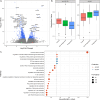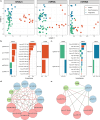Multi-omic signatures of sarcoidosis and progression in bronchoalveolar lavage cells
- PMID: 39080656
- PMCID: PMC11290275
- DOI: 10.1186/s12931-024-02919-7
Multi-omic signatures of sarcoidosis and progression in bronchoalveolar lavage cells
Abstract
Background: Sarcoidosis is a heterogeneous granulomatous disease with no accurate biomarkers of disease progression. Therefore, we profiled and integrated the DNA methylome, mRNAs, and microRNAs to identify molecular changes associated with sarcoidosis and disease progression that might illuminate underlying mechanisms of disease and potential biomarkers.
Methods: Bronchoalveolar lavage cells from 64 sarcoidosis subjects and 16 healthy controls were used. DNA methylation was profiled on Illumina HumanMethylationEPIC arrays, mRNA by RNA-sequencing, and miRNAs by small RNA-sequencing. Linear models were fit to test for effect of sarcoidosis diagnosis and progression phenotype, adjusting for age, sex, smoking, and principal components of the data. We built a supervised multi-omics model using a subset of features from each dataset.
Results: We identified 1,459 CpGs, 64 mRNAs, and five miRNAs associated with sarcoidosis versus controls and four mRNAs associated with disease progression. Our integrated model emphasized the prominence of the PI3K/AKT1 pathway, which is important in T cell and mTOR function. Novel immune related genes and miRNAs including LYST, RGS14, SLFN12L, and hsa-miR-199b-5p, distinguished sarcoidosis from controls. Our integrated model also demonstrated differential expression/methylation of IL20RB, ABCC11, SFSWAP, AGBL4, miR-146a-3p, and miR-378b between non-progressive and progressive sarcoidosis.
Conclusions: Leveraging the DNA methylome, transcriptome, and miRNA-sequencing in sarcoidosis BAL cells, we detected widespread molecular changes associated with disease, many which are involved in immune response. These molecules may serve as diagnostic/prognostic biomarkers and/or drug targets, although future testing is required for confirmation.
Keywords: DNA methylation; Epigenetics; Gene expression; Multi-omics; Sarcoidosis; microRNA.
© 2024. The Author(s).
Conflict of interest statement
L.A.M. has received grant support from the Foundation for Sarcoidosis and Mallinckrodt Pharmaceuticals and serves on the advisory board for the Foundation for Sarcoidosis and the sarcoidosis advisory board for Boehringer Ingelheim. I.V.Y. has received financial support to attend the 2023 World Association for Sarcoidosis and Other Granulomatous Disorders conference and consulting fees from ElevenP15 unrelated to this work. The remaining authors do not have conflicts of interest relating to this work to disclose.
Figures




Update of
-
Multi-Omic Signatures of Sarcoidosis and Progression in Bronchoalveolar Lavage Cells.bioRxiv [Preprint]. 2023 Jan 27:2023.01.26.525601. doi: 10.1101/2023.01.26.525601. bioRxiv. 2023. Update in: Respir Res. 2024 Jul 30;25(1):289. doi: 10.1186/s12931-024-02919-7. PMID: 36747844 Free PMC article. Updated. Preprint.
References
MeSH terms
Substances
Grants and funding
- R01 HL140357/HL/NHLBI NIH HHS/United States
- R21 ES036375/ES/NIEHS NIH HHS/United States
- R01 HL153613/HL/NHLBI NIH HHS/United States
- UL1TR001082/TR/NCATS NIH HHS/United States
- R01 HL162955/HL/NHLBI NIH HHS/United States
- 22-505-RFP/Foundation for Sarcoidosis Research
- R01 ES034767/ES/NIEHS NIH HHS/United States
- K23 HL163313/HL/NHLBI NIH HHS/United States
- R01HL140357/HL/NHLBI NIH HHS/United States
- R01ES023826/National Institute of Environmental Health Sciences,United States
- R01 ES033678/ES/NIEHS NIH HHS/United States
- UL1 TR001082/TR/NCATS NIH HHS/United States
- R01 ES023826/ES/NIEHS NIH HHS/United States
LinkOut - more resources
Full Text Sources
Molecular Biology Databases
Miscellaneous

